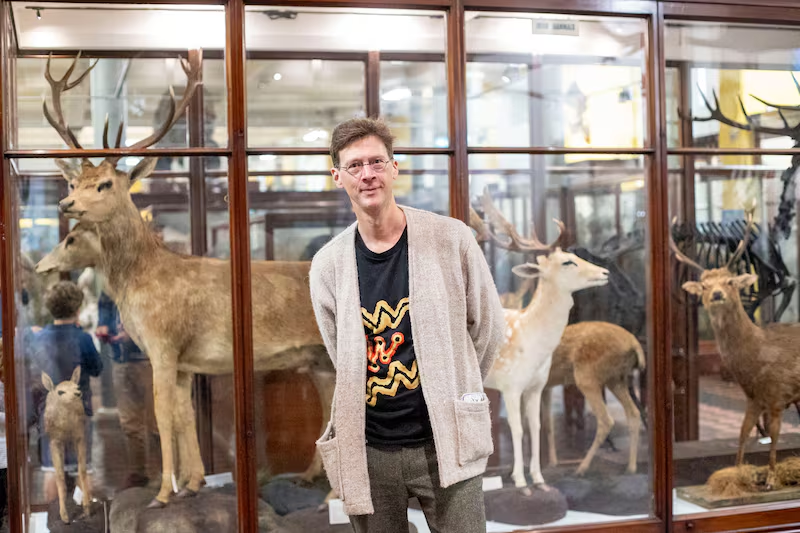“Just off the main N5 road to Co Mayo, there’s a small hole in a field at the bottom of a grassy lane that was believed to be an entrance to the Otherworld and that was known as a ‘hell mouth’ or ‘Dorus iffirn na herend’, Ireland’s door to hell.” This is a quote from Manchán Magan’s latest book Wolf-Men and Water Hounds: The Myths, Monsters and Magic of Ireland, which takes us to 18 magical landmarks across the country.
The “hell mouth” in Tulsk, Co Roscommon, is called Oweynagat Cave, from the Irish Uaimh na gCat or Cave of the Cats. It is named for the three ghostly wildcats that lived at the bottom of the cave and fought any warrior brave enough to attempt entry. The cave, Magan explains, is a rite-of-passage site where ancient goddess energy resides. “Queen Maeve said to the warriors, ‘you go down into me hole, and there will be my wildcats and they will rip you asunder’.” The victor was the rare fellow who came back out alive. As an aside, Magan also mentions that according to legend, no king or warrior in Ireland could achieve their status without having “laid in a bed with Queen Maeve. You know, this was a time in Ireland when women ruled everything”.
Talking to the writer about his work requires a little suspension of belief and a willingness to have your head melted a bit. As he says himself: “Myths are beyond reason, beyond thinking.” We’re sitting on a bench in Merrion Square with the sound of a drum-fuelled American football rally wafting over the trees. It was lashing rain when we met earlier outside the Dead Zoo for a photo shoot. The rain having cleared and photos taken, we’re sitting beside a bush in the park while tourists stroll past. It feels right to be talking to Magan in nature. He lives, mostly self-sustainably, on a 10-acre plot of land in Co Westmeath.
Magan is many things, but he mostly likes to describe himself as “a communicator”. He’s a travel writer who has written on India, Australia, South Africa and South America who now tries to avoid flying as much as he can for climate crisis reasons. He’s a scholar of indigenous cultures and a spiritual seeker. He’s an Irish language speaker and documentary maker, his latest is on holy wells, and he helps run an online hedge school, Scoil Scairte, celebrating the Irish language.
READ MORE

The great-grand nephew of republican leader Michael Joseph O’Rahilly, known as The O’Rahilly, he has been writing and broadcasting “on the margins” for 25 years. Once a self-described “outsider and loner”, he first came into the public eye in the mid-1990s when he was on a spiritual quest, drinking his own urine and living in a cowshed in the Himalayas. That’s when a TG4 camera, wielded by his brother Ruán, was first put in front of his face. His brother chastised him for the “dipsy idealistic dream” he was spouting at the time. “And he was right. I knew I needed to find a more pragmatic way to speak to people.”
He appears to have found it. The former outsider went fully mainstream in the last few years, finding large audiences for books such as Thirty-Two Words for Field, which interrogated what the Irish language tells us about the landscape, psyche and heritage of this country. Tree Dogs, Banshee Fingers and Other Irish Words for Nature was a companion book and featured illustrations by Steve Doogan. His most recent, Listen to the Land speak, uncovered more secrets buried in the Irish landscape.
Wolf-men and Water Hounds, also illustrated by Doogan, is a companion to that book. Magan looks at various enchanted sites “portals and thresholds to otherworlds” and tells stories of legendary beasts or sea creatures across the four provinces. You’ll find out about the water hound (dobharchú) of Achill Island, or the salmon with one eye from Ballyshannon. There are, in case you weren’t aware, man-wolves in Ossory, Co Kilkenny. As a fan of the Burren, I was intrigued to learn about the ollphéist or great serpent said to live there. There’s a hairy worm (Caoránach) of Lough Derg, and even an enchanted sow, Cailcheir, which can be found in the caves around Keshcorran Hill in Co Sligo. Manchán fans – Manchies? Manchánites? – will lap it all up.
[ Manchán Magan: The train to Spain to visit wildlife plainsOpens in new window ]
The week we meet, two of his previous books have re-entered the top 10 best-seller list. Nobody is more surprised by the success of his books than Magan, but he feels the timing is right for what he’s trying to communicate. “During Covid, you saw how people were nourished by getting out on to the land. And I know, having struggled when I was younger with not fitting in, how opening myself to the land helped. I’d love for more of us to be able to do that.”
He also knows how it can be an intimidating prospect. “I sometimes go to the Hill of Tara and it does nothing for me ... there’s all these people going up and doing cacao ceremonies and one legged yoga and they make the rest of us feel inadequate. I want to make the land enjoyable in a lighthearted way.”
He mentions the different ways these myths and legends have been interpreted throughout Irish history, from WB Yeats and Douglas Hyde to Marie Heaney, widow of Seamus, and her book Over Nine Waves. “In a time of climate change, when we’re really worried and we don’t trust the land or the weather, these stories will be vital to us. And we’re going to have to find new ways of telling them, it can’t just be about the great Cú Chulainn beheading everyone or Fionn mac Cumhaill being a grumpy old man.”
The only way humans have managed to survive is by being in tune with and connected to their surroundings
Magan reckons he is one of the only people who have been to all 18 sites in the book, but he hopes more will be encouraged to visit them. What are his favourites? The Hill of Uisneach in Co Westmeath because it is the “heart centre of our firmament, the central node around which the entire matrix of our existence revolves ... I’m not the most sensory person, but when I stand there I get dizzy, I think anyone would ... but you have to use your imagination.”
He likes the Madman’s Chair at Dunany Point, Co Louth, where according to myth there’s a rock on the strand said to transport people from the world of madness to sanity. “It reminds us how mental health was a key facet of the lived experience for our ancestors, and there were tangible ways of dealing with mental health issues in what we often considered the more primitive times of the long distant past ...”
He also delights in “the otherworldly palace” of Midir, son of Dagda, at Brí Léith on the hill that is now known as Ardagh, Co Longford. “I love this, because today it’s such a drab, unassuming site of conifer plantations, just southwest of Longford town, and yet it’s associated with such passions and love and dramatic adventure and the story of Midir’s beloved young goddess Étaín.”
An upcoming project also has a female focus. During his research for 32 Words for Field, he discovered more than 40 Irish words for penis and began to wonder about the lack of recorded words for women’s genitalia and bodies. He joined forces with women artists for an upcoming exhibition and accompanying catalogue called Focail na Mban. The words and phrases they have illustrated are fascinating. Breall, for the clitoris, which also has the unfortunate translation of “blubber lip” or “ugly protuberance” or “someone prone to blundering”. Ribe an tsiabhrán is another name for the same body part which translates, hilariously, as “bristle of delusion” or “tuft of mental confusion”. Faighin is vagina, a “scabbard or sheath”. Bléin mná is a woman’s groin or crotch. “It literally means a woman’s cove or cave.” Clais is a word used for vulva which means gully or gash or ditch. And Riasc rúnda is a brilliantly apt phrase to describe the vagina – the literal translation is “secret marsh”. He hopes when the project is launched it will encourage women in Gaeltacht areas and elsewhere to gather and pass on other forgotten or lesser-used Irish words.

He returns to women and female energy a lot in conversation. He believes that if we can picture parts of our landscape, the River Shannon say, as not just a waterway but as “a gifted young goddess” with hopes and desires and dreams, it’s more difficult to stand by while farmers pollute her with nitrates. “If we do realise our rivers are goddesses, the Shannon, the Boyne, the Bann ... with this rising female energy, we might just say ‘no f**k you’ to this tiny group of farmers.”
Magan explains that he has two agendas with his work. The first is to connect people deeper to the potency of the land, “because I believe that people who are alienated from the lands cannot survive. The only way humans have managed to survive is by being in tune with and connected to their surroundings. If we break that bond, we won’t survive very long”.
His other ambition is to “reanimate” the world. “I want to remind people of the energy that connects them to their body, their mind and the land. For most of our existence we’ve believed in animism, that every rock and flower and branch and rainbow has within it the vibrating spirit of energy or of god, or of some all-powerful entity that is beyond, above and more than human. I want us to remember that spirit within ourselves and within all things, as it makes life so much more enjoyable and rich and magical, and also it ensures that we treat each other and our environment with more love and respect and care.”
[ Manchán Magan: Irish mythology might contain the guidance we need right nowOpens in new window ]
He is self-deprecating about his recent success – “I’m blindly feeling my way” – and about how long it might last. “I’ll probably have a year and a half and then I’ll either move on or be cancelled. Better still, women in their 20s, or 30s are going to come along to tell these stories. I mean, I shouldn’t be the one telling stories about these goddesses. I see young women already saying this stuff only with far more wisdom.”
Magan is one of those bright, rejuvenating, esoteric people, a Birkenstock-wearing beacon of love, courage and curiosity. You just feel better about all that ails both you and the planet we call home after an encounter with him. That’s how I feel anyway, as we wander across the street to unlock our bikes, the pavement still slick with rain and the sound of not-so-distant drums filling the air.
Wolf-Men and Water Hounds: The Myths, Monsters and Magic of Ireland is published by Gill. Focail na mBan, an art exhibition with accompanying catalogue, will launch in the Fumbally Cafe, Dublin 8, on Thursday, November 23rd. See thefumbally.ie


















